If you follow me on social media, you may have seen a tribute post for the Bubbles of Hope members. I thought it would only be fair to give them a shout out on this blog too.
The group had its very first cleanup on the 2nd April 2022. The goal was to get out once or twice a month, but I quickly realised it wouldn’t be as easy. First I had to find young divers eager to join to help me make a difference. To find them I started scouting in my class by simply asking, and extended it to my whole school with a poster set up in the hall and later distributed by the teachers to the targeted year groups. A letter published in our weekly newsletter was also shared in hope to reach both students and parents. As I had joined several reef cleanups myself where I was the only minor, I really wanted this group to be made up of teens only, from 10 to 17 years. Little by little some students accepted to be part of Bubbles of hope, making it official by purchasing the t-shirt with the logo I had designed.
Today, Bubbles of Hope has 11 members, from 11 to 16 years. Mostly – but not only – from my school. I knew one of them from outside school, and I was very happy to receive a request from a homeschooled teen girl traveling around the world, currently based in KK. She had come across a post about this group and was eager to join! Did I mention I also have four pairs of siblings which is absolutely awesome; not to forget two sisters who have since then moved overseas but regularly come back and make a point to do a reef cleanup with us.

Unfortunately gathering everyone on the same day happened to be quite tricky. Young people are definitely busy during the weekends, despite what people might think. Tuition, classes, family plans… We still haven’t had a chance to be all together at once. But with a bit of luck and eagerness we did manage to achieve 12 cleanups in 17 months and I couldn’t be more grateful for that. I also wanted to highlight one of my IG followers, a fellow young diver from England who messaged me that she was very inspired by our group. She decided to do some cleanup herself in the nearest park to her house with a friend and sent me the video, since diving is not as accessible for her as it is for us. I couldn’t be more happy to know our group can reach youth literally across the world who are inspired enough to do their part. The saying do good and good things will come back is very true in our case. What better reward than bumping into a turtle, some shy reef shark or even a whaleshark like we did at the beginning of this year!
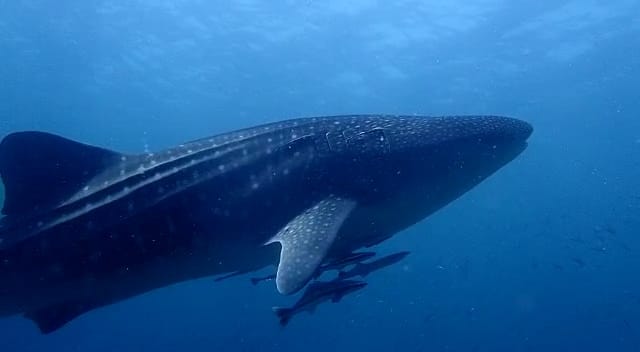
Glad to announce we have two new members ready to join. I said it before but I can say it again: Bubbles of Hope is constantly looking for young divers to join us. Thanks to Scuba Junkie Kota Kinabalu we have a boat, a captain and divemasters ready to support us. I hope more youth will be onboard in the future. I know this project might feel like a drop in a huge ocean but I believe anything is better than nothing – and I definitely hope that this will create a continued wave of change in each of our members’ lives. We are very lucky to live in a place where the temperature above and underwater are really tropical all year long; the marine park is 10-15 minutes away. I know how lucky we are and I believe it would be a shame not to give back to the environment with these idyllic conditions. Each piece of trash/plastic removed makes it feel better and gives us a purpose as young divers.
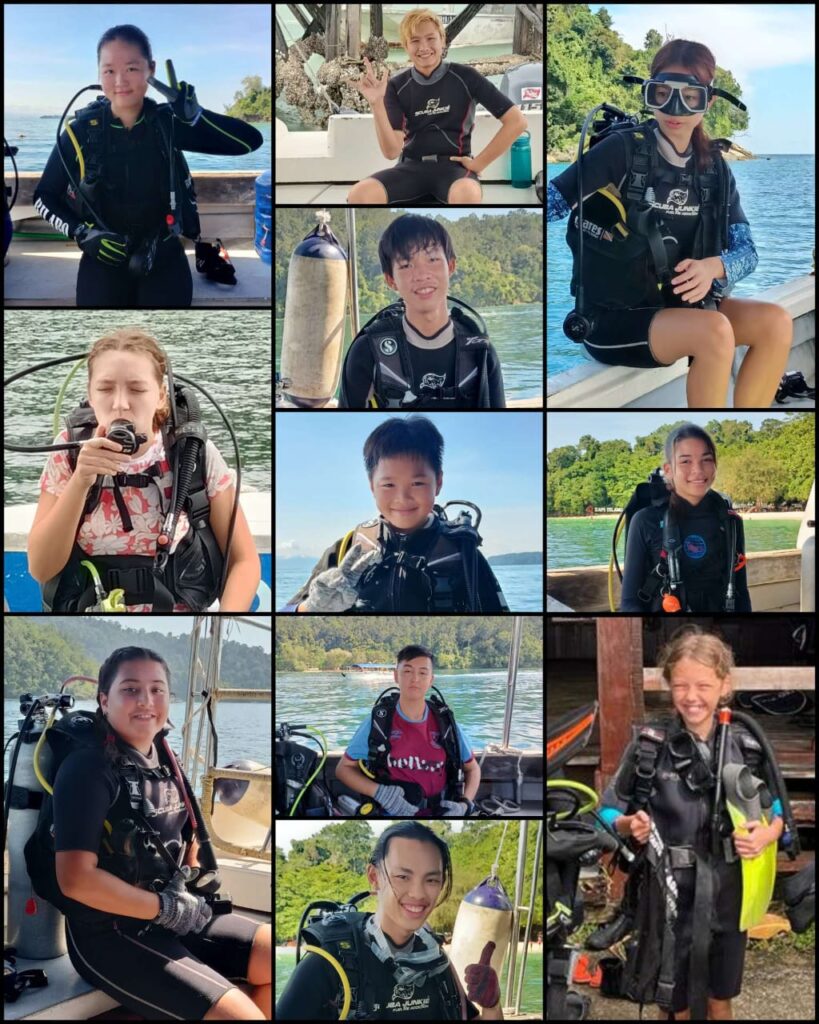
As always, looking forward to the next time I can meet up with my cleanup gang and we can not only make a difference, but have a blast while doing so. Julia
Saturday 16th September was both Malaysia Day and International Coastal Cleanup Day. A good excuse for Bubbles of Hope to go out again and enjoy the beauty of our Sabahan underwater world while chasing any trash that is polluting it. After all, even if ‘coastal’ refers to the border next to the sea, we have to remember that pollution has no such boundaries and eventually ends up deeper in the ocean.
Five of us boarded one of Scuba Junkie’s boats with Jason and Alex, our two DMs for the day. With optimal conditions – water temperature 30°C and visibility up to 15 meters we were in for a great day, ready to do our part, and have fun!
Very happy to report our first dive site was clear of trash! After 45 minutes of trash hunting, we came back with empty mesh bags except for one plastic bottle. The kind of failure that feels like a victory. Pik Yen and Isabella even found time to play rock, paper, scissors to celebrate during our safety stop 😉
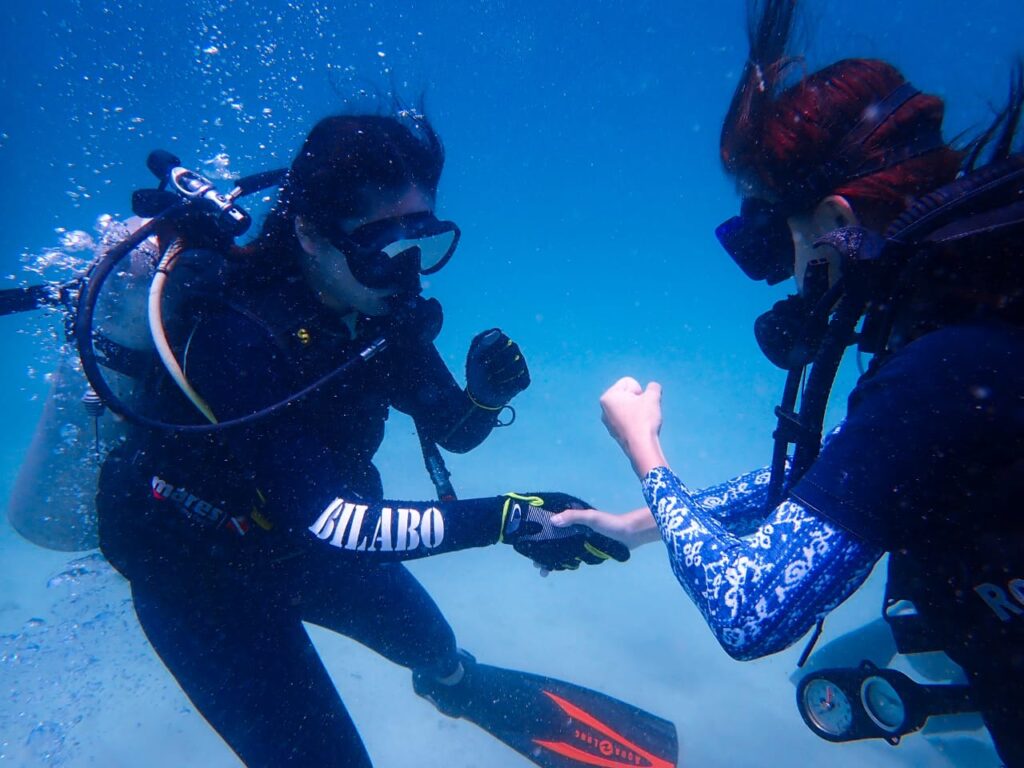
A quick snack and then onto a small cove of white sand that looked empty from afar. But behind the big tree roots lots of plastic bottles, packaging and diapers were there, ready to stay for the next hundreds of years. When plastic takes over nature, nobody wins. We removed 3 big trash bags before it was time to head out again.
After the second dive – no trash either – and lunch, we decided to use our free time on the beach to have some fun.
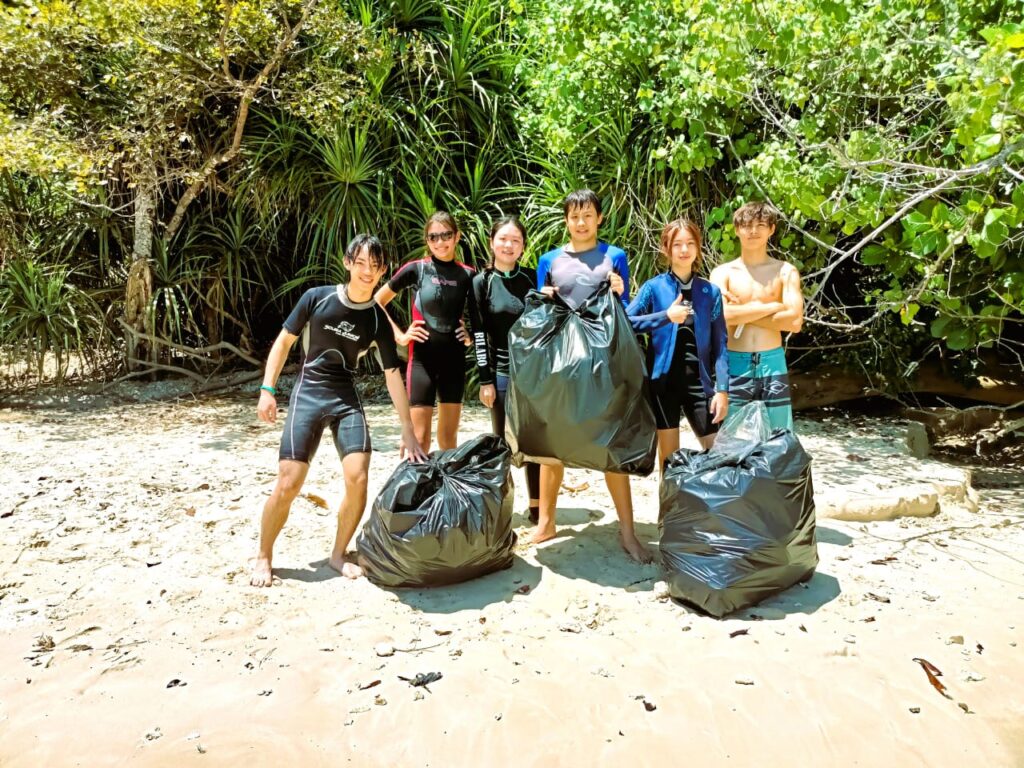
Work hard, play harder
Let’s not forget that Bubbles of Hope is a group of teen divers. And although it may sometimes sound like tedious work to remove trash, we actually have a lot of fun in the process; both under and above the water.
Once the diving part is done, there remains a group of young people who just want to keep the fun going. Give us a beach, a bit of sun and a beach ball, and we will make the best of it. Sand in my hair was all worth it after an epic battle of sand balls, as we all left with a huge smile on our faces. To me, there’s no better sight than to see youth reconnecting with nature, having fun, and bonding together – a luxury that we never take for granted.
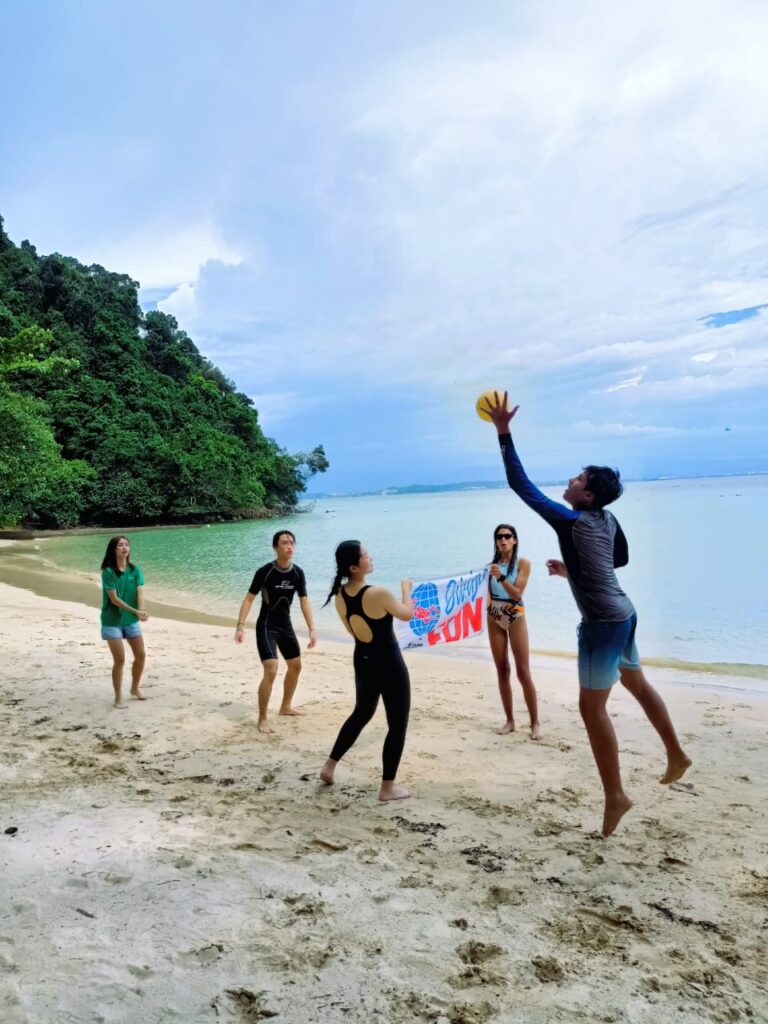
Overall, we may not have found so much trash underwater, but to me this trip was a success yet again. We still managed to do our part for the park and the fun that we had that day was a reminder of why we are protecting such an amazing place.
Bubbles of Hope #12 was a blast! Definitely looking forward the next one…
Julia Rabenjoro
Saturday 16th marked the 10th Bubbles of Hope reef cleanup done and a very special one for multiple reasons.
As usual, our day started at the Jesselton Point Jetty, heading off under the bright sunshine and blue skies. Our first dive site was Sulug House Reef where we immediately ran into ‘Bumpy’ the residential humpback hawksbill turtle. Shortly after, we emerged from the warm waters with a bag full of trash collected from the sandy bottom and headed to a small, secluded island for our surface interval.
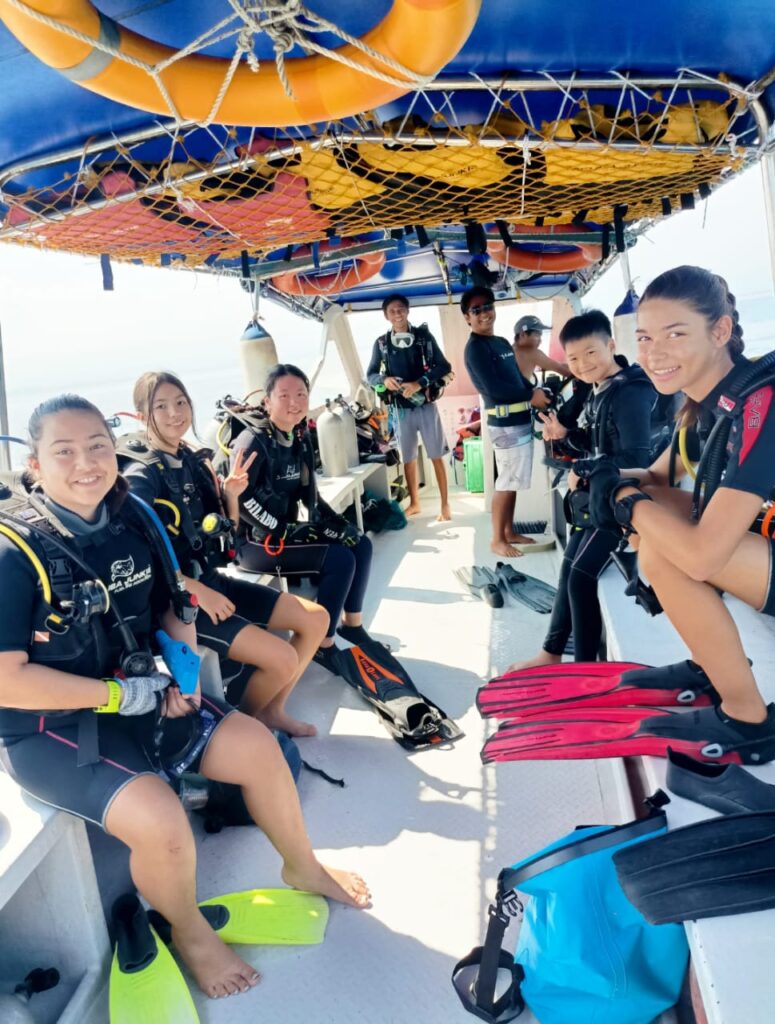
Normally, we would do a beach cleanup in this exact location, but today was a special day as it was the last time we would be diving with one of our divemasters/buddy, Awie, for a while. And so instead, we ate some cakes kindly brought in by Pik Yen, one of our teen divers.
It wasn’t long before we were heading off again to our fun dive yet again near Sulug Island. As we hurried to get into the tropical waters, no one expected what was to come…
The visibility was incredible – probably the best one I’ve seen in the park – and we excitedly roamed the top reef before coming to the slope where we followed a humongous school of bigeye snappers on our right shoulder. We continued along the edge, finding beautiful block corals, soft corals and an adorable, vibrant purple nudibranch.
Eventually, the visibility seemed to get a little foggy, and we headed back the way we came, running into our school of snapper friends again and taking many more pictures and videos. At last, in exactly the right location at the right time, a spotty shadow loomed towards us from the blue. The shape and pattern was undeniable: we had run into a whale shark mid-dive!
Squeals of joy, denial and disbelief bubbled to the surface as it looped around us slowly, yet efficiently, and we took as many pictures and videos as our cameras could hold. After it had faded away into the blue again, the magical feeling still lingered and each mask had wide eyed gazes.
Shortly after that, a chubby black tip reef shark came by just to make the dive even more incredible then it had already been, and we resurfaced in cheers and awe.
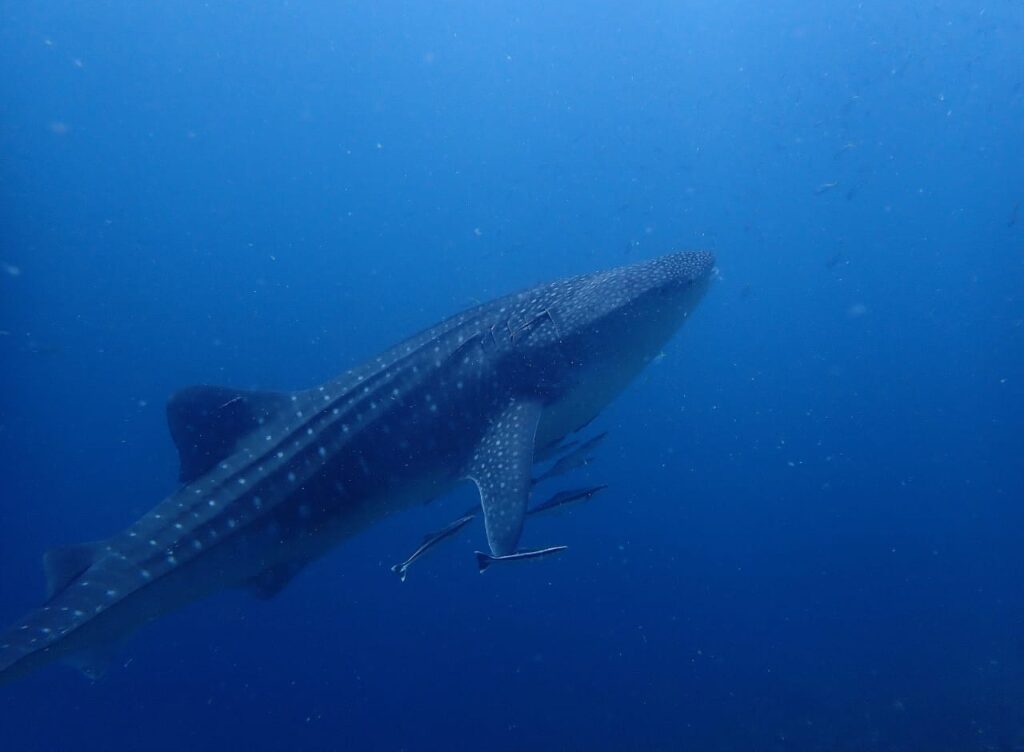
As we headed to lunch, there was no other topic of discussion but endless recounting of funny reactions and excitement as we rewatched the videos captured.
After lunch, logbooks were filled with drawings and bold titles of ‘WHALE SHARK!” and it was so amazing to think that for Isabella, one of the teen divers, this had been her very first encounter with one of these majestic creatures. And for Lung Ip who is only 11, this had been his second time in only 35 dives! A special dessert was the cake that I baked as a goodbye to Awie and each of the present members had signed it with a short message.
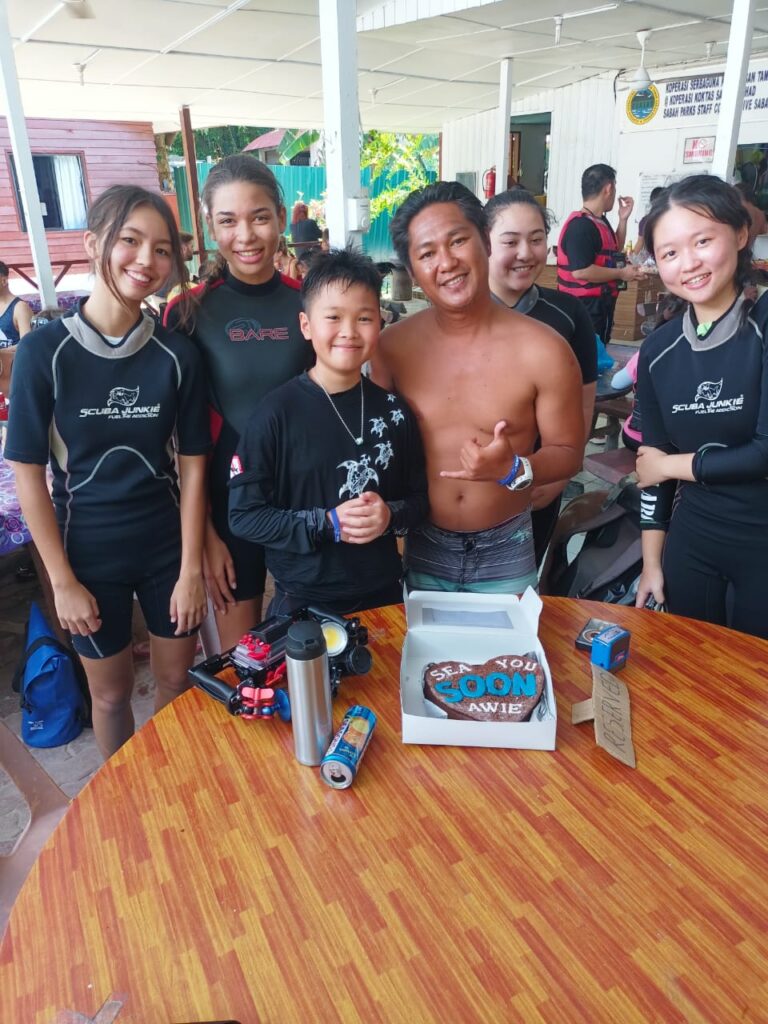
Nothing but happiness and stories returned to the shocked parents. This was an amazing reminder of what we are doing these cleanups for. It was a real-life (unexpected!) encounter with one of our rarest marine neighbours and it was just the most perfect way to send off Awie and to celebrate our 10th Bubbles of Hope dive trip!
I am very much looking forward to many more to come, and am more than ever motivated to help clean up our watery home.
Happy Bubbles!
Julia (Bubbles of Hope)
One of the most common things we teenagers hear from our parents is “Clean your room!” and “Pick up your stuff!” And let’s be honest, we suddenly have hearing problems and a million other priorities…
But when it comes to cleaning up underwater, it’s a different story. My name is Julia. I am a 15 year old PADI AmbassaDiver and a Junior Master Scuba Diver.
A few months ago I had the idea to gather young divers to dive with a purpose. After all, it’s never too early to start. After 7 years of scuba diving in the Tunku Abdul Rahman Park, seeing trash floating or stuck underwater and noticing more and more kids being certified, I thought: how cool would it be to join forces and do something good for the ocean!
I created a logo, found a great printer shop and Bubbles of Hope was born.
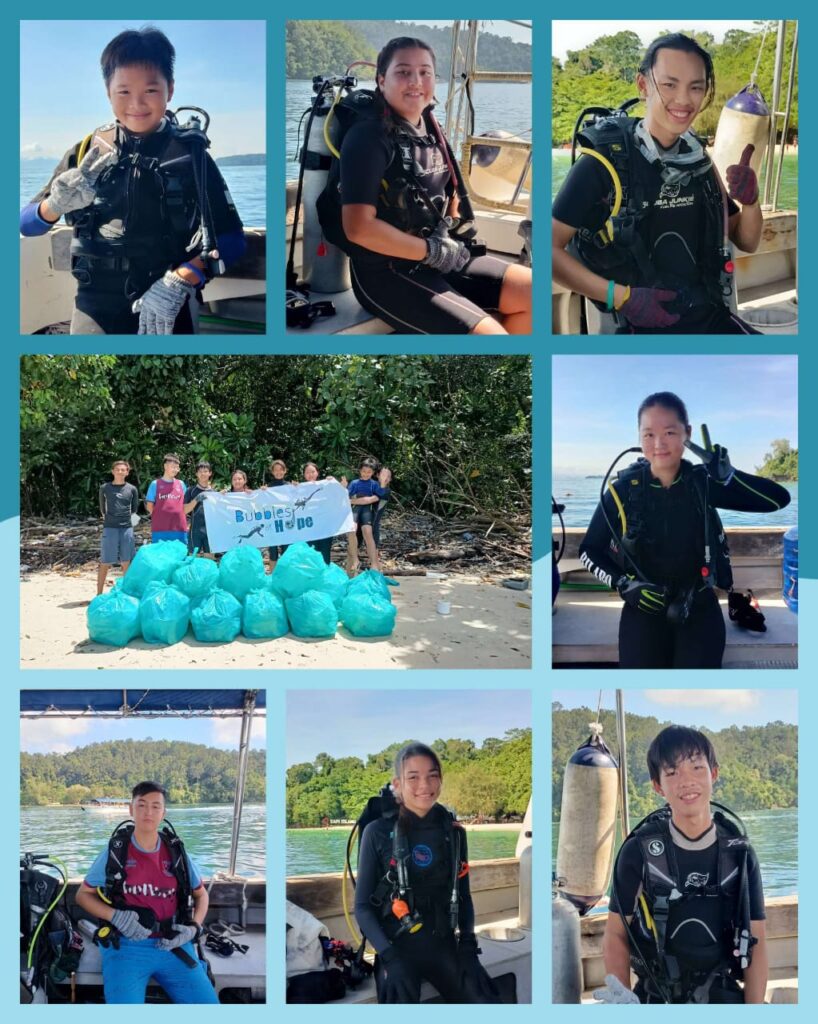
It’s not always easy to find the right day to accommodate everyone but also not impossible. Partnering with local dive centers is much easier and I am so grateful for that!
Scuba Junkie immediately accepted to jump on board and hosted our 6th reef cleanup last month.
There were 7 of us meeting up at Jesselton by 8am (yes, teens can wake up early during the weekend for a good cause!) and off we go, wearing our Bubbles of Hope t-shirts! Everyone is chatting and excited, the sun is shining brightly and with Awie and Jason, I know we are in good hands. Briefing, gearing up, mesh bags ready, one by one we are back rolling into Sapi House reef.
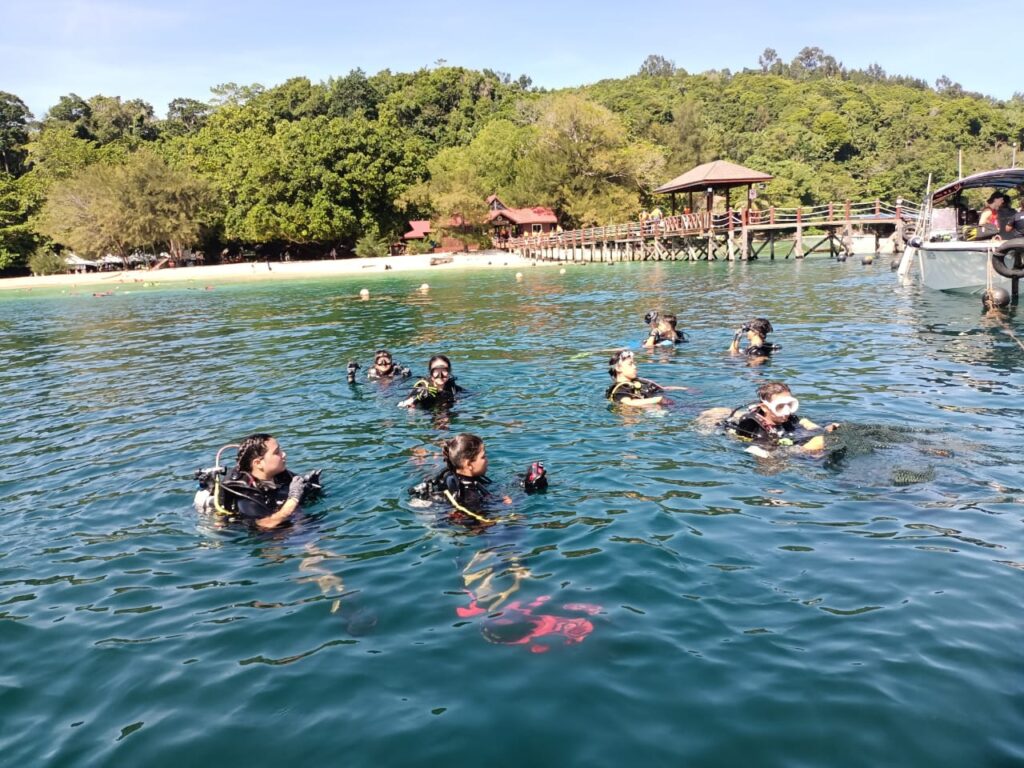
Split in 2 groups we worked together, keeping our buoyancy in control and helping each other out and had a pretty bitter-sweet outcome. Very sad to have seen so much trash but glad that we were able to get 3 and a half large mesh bags of rubbish out of there!
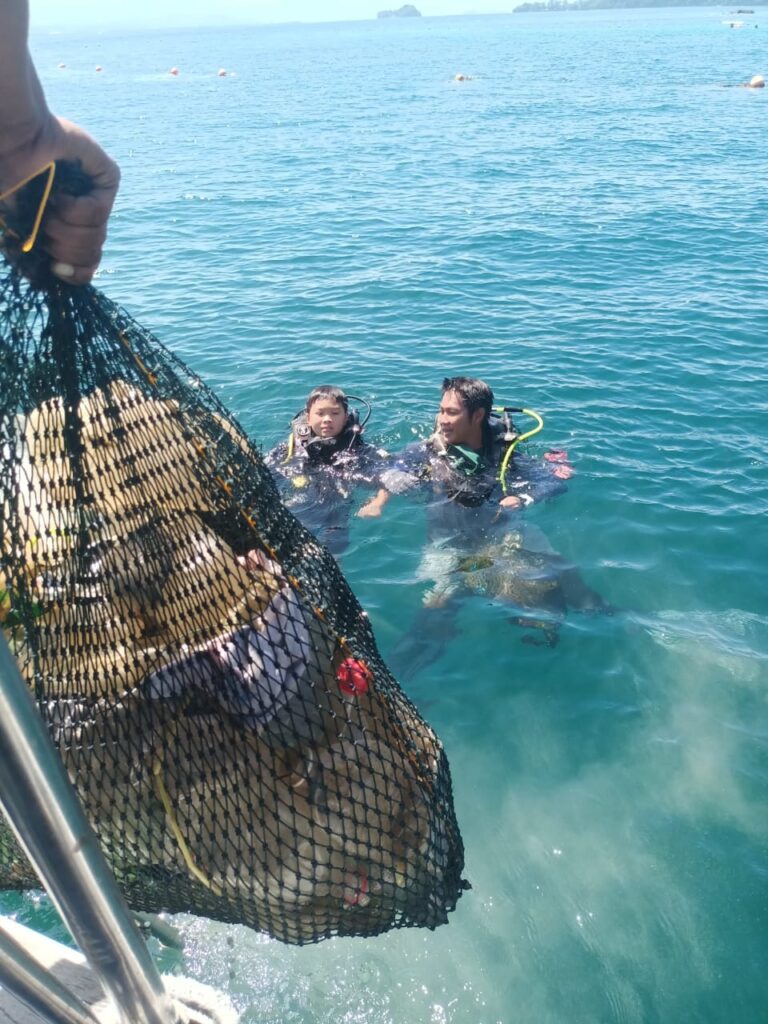
We used our surface interval to head to an occupied beach where we got to work on the mounds upon mounds of plastic bottles, food packagings and polystyrene that had washed up on the beach and in the vegetation. Led by our 2 dive masters we created an organized system to collect, crush and bag up as much trash as we could, and despite the time and limited workforce, we were able to get 16 bags of rubbish off that beach! We even had the unexpected help from a nice couple who were chilling with their own boat and were happy to give a hand. I hope the macaque who was watching us from afar appreciated our collective efforts. Of course, there was still a lot left so we’ll be back! Then we headed to Gaya Island, where we took a break from pollution to go on a fun dive and enjoy the beauty of the park we are working so hard to preserve! Cameras were out and lots of vibrant, colourful coral and fish were spotted.
Exhausted but satisfied with our work for the day, we headed to the other side of the island for a delicious, well deserved lunch followed by a peculiar competition of sand balls and leisure swims in the warm, tropical waters.
It was a very productive day and it’s so promising to see such interest and dedication reflected in this group.
So yes, we might not be the champions of cleaning our bedrooms but I can tell, we did a pretty good job with Scuba Junkie! And it’s just the beginning…
Please get involved! If you are/know any PADI certified teen divers (10-17 years old) who might be interested to join, don’t hesitate to contact me for more details on:
Instagram: @julia_into_the_blue
Facebook: Seed of Hope
Email: juliaintotheblue@gmail.com
If you aren’t a diver, then please show your support to our efforts by checking out the social media handles or spreading the word about this project. The more people we have, the bigger difference we can make!
I hope to see you underwater! Keep diving and happy bubbles! Julia
Do you still remember the time when you first took your Open Water certification? If yes then you will surely remember the time where your instructor taught you how to log a dive properly after you finished your dive. Most divers only came to know about a dive log when they take their Open Water course while some already have had experience with it during Discover Scuba Diving. Some of the divers still keep an active dive log after years of scuba diving. However some no longer do it as soon as they complete their course. So should you keep a dive log? and why should you keep a dive log? Have a read at the below 6 reasons why a dive log is important.
The first important reason why you should keep a dive log is as a proof that you are an experienced diver. While a certification card is enough to prove you as a qualified diver to go diving, you will need a dive log to advance to the next level. All major diving organisations require divers to have a minimum number of logged dives in order to enrol in some of their diving courses. This is especially important if you are thinking of going pro in your diving career as you will need to reach a certain number of dives before you can begin the Divemaster or Instructor course. So having a dive log is a proof that you are an eligible candidate for the course.
Having a dive card is simply not enough when you go diving sometimes. This is due to the diving conditions being a bit challenging in some places. Therefore dive shops will need to make sure that you have enough experience to do the type of diving that you are planning to do. Liveaboard’s may ask you to show your dive log before you can go on their boat.
Diving is a lifelong learning process. You might feel nervous & make a few mistakes during the first couple dives. The only way for you to improve yourself is if you keep a dive log. You can write down the difficulties that you faced during a dive and discuss it with your buddy or the guide after a dive. Those few tips from them can help you to stay longer and become more comfortable in the water in the future. You learn something different with every dive. Logging a dive will help you to identify the skills that you need to work on so that you can have a more enjoyable diving experience. From how to control your breathing, managing your buoyancy underwater to even fish identification! There is always room for improvement regardless of the number of dives that you have under your belt. Logging a dive can help you to keep track of your learning progress & become a more confident diver!
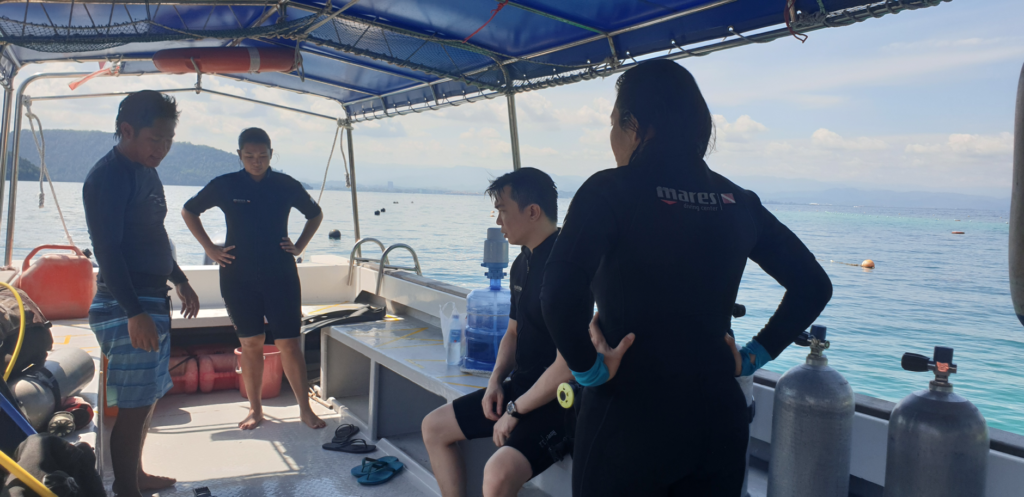
A dive log is just like a passport for a diver. It is full of different stamps from different dive shops around the world. A lot of divers love to collect dive stamps as it helps them to remember all the places that they have dived in. Each dive shop has their own unique stamps. An instructor or guide will usually sign & stamp your logbook after each dive. It’s a proof that you have gone diving with them. You can always start a conversation with your diving buddy by showing them the dive stamps that you have collected. Sharing dive stamps with your buddy is definitely a fun topic to talk about after an amazing day of diving!
Diving equipment is vital for divers underwater. The equipment can vary slightly depending on the water temperature & diving condition of the area that you have visited. The different types of diving suits that you wear can affect the amount of weight that you need. You will waste a lot of time experimenting with different weights until you obtain neutral buoyancy. This won’t be a problem if you record all your dives. By doing so, all the information in your logbook can serve as a reference for your future dives in all kinds of situations. You can make the most from your dive when you don’t need to waste time adjusting your gears for each dive.
We have to understand that there’s a limit to a human’s memory. You won’t be able to remember all the dives that you have done in the end. However keeping a dive log can preserve all those beautiful memories for you, which is why many divers use their dive log as an underwater diary. You can record everything about the dive in your logbook. For example, what did you like about the dive, what makes you feel uncomfortable under the water, what marine life that you have seen & so on. You will be able to look back all the details and great memories of each dive trip.
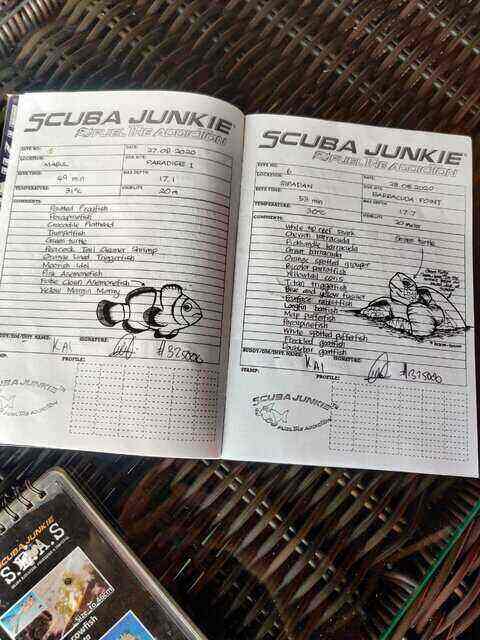
It is not necessary to have a dive log for fun diving, at the end it’s just merely a personal choice. But we hope the reasons above will make you start to log your dives as it definitely brings more good than harm to you and will remind you of all the great dives you have had!
Who wants to go scuba diving? We are thrilled to announce that diving is now permitted and that we are open and ready to leap back into the water for some amazing dives!
We are currently running special promotions with great discounts to welcome you back, and if you are concerned about the situation changing, don’t be! We have a worry-free guarantee, so if your schedule changes and you are unable to attend, we can reschedule.
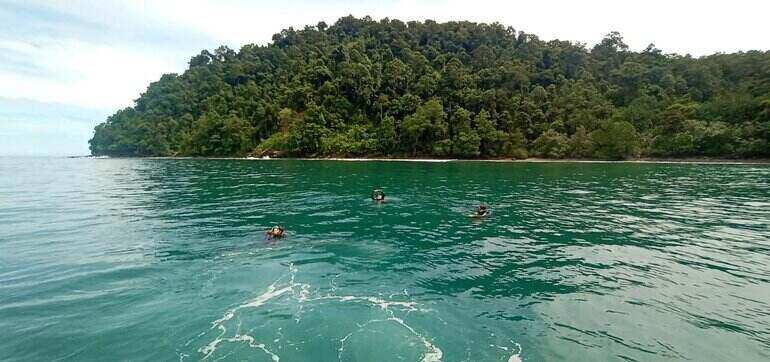
Scuba Junkie Kota Kinabalu has always prioritised the safety of our guests and staff, not only underwater but also on the surface. We have put in place a thorough SOP to provide you with a safe environment while you enjoy your epic dives, making it a day to remember!
The following are the key requirements that we will follow:
Our boats will only be filled to 50% capacity, and you will be assigned a seat for the day to ensure that we adhere to social distance standards. To avoid contamination, boats and dive gear are thoroughly sterilized and cleaned.
We are pleased to announce that all of our employees at Scuba Junkie KK have been FULLY vaccinated.
To be able to dive with us now ,you must have been fully vaccinated for at least 2 weeks and provide us with your certificate.
As a safeguard for other guests, our staff and the local community, we at Scuba Junkie urge you to comply with these guidelines. Our dedicated staff have been trained to follow and carry out these measures to ensure that your dive trip is as enjoyable and amazing as you imagined it, even during these extraordinary times!
Thank you very much for your support. Let’s fight Covid -19 together and keep diving!
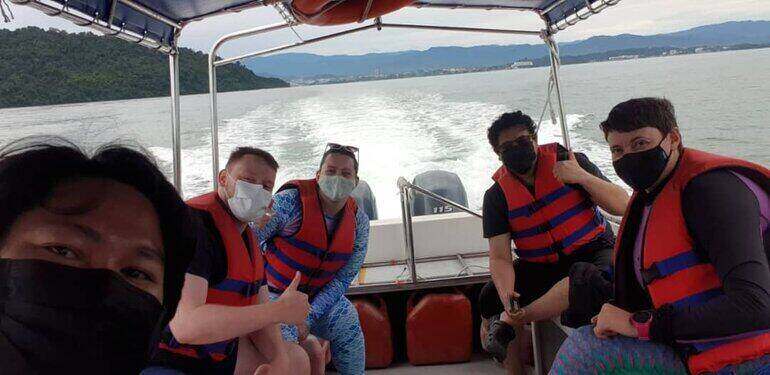
New to diving and want to try? Come and try out our Discover scuba dive, there is no theory and you even do your learning skills in the ocean seeing lots of marine life!
Been bored during lockdown and want to learn something new? We have a wide range of courses from beginners PADI Open water course, to continuing your education with Advanced Open water and Rescue!
Already certified and simply just want to roll into the water and have an awesome relaxing dive! We have you covered with 3 amazing fun dives in the KK marine park guided by our super friendly & professional divemasters, ensuring it is a day never to forget!
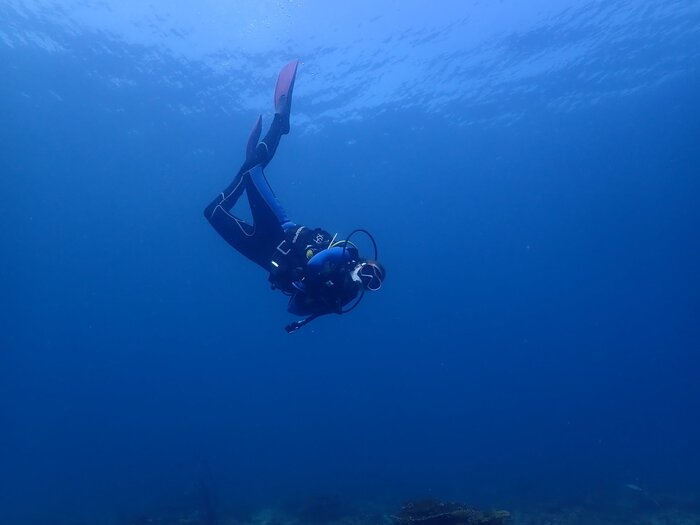
We can’t wait to welcome you back for some amazing experiences. Lets go diving together and explore the magical Tunku Abdul Rahman Marine park again!
Fill in the booking request below to book or contact us for further enquiries.
Diving is an adventurous activity that involves a lot of unexpected elements underwater and can quickly and potentially turn a fun, relaxing getaway into a stressful situation. The Rescue Diver course will teach you how to prevent and manage problems in the water while also increasing your confidence as a diver. At Scuba Junkie Kota Kinabalu this is one of our top courses to teach as it is so much fun and very rewarding.
Here are just some of the benefits of becoming a Rescue Diver.
The Rescue Diver course will teach you new techniques and ways to apply your water skills in a crisis situation. By practicing problem-solving skills until they become second nature, you will learn to be a better buddy. With skills and training comes confidence, and the Rescue Diver course is designed to help you build that confidence underwater. This course is often described as the most challenging, yet most rewarding.
The Rescue Diver course includes lessons on becoming more aware of your surroundings and environment. Navigation. It’s something that some of us either mastered right away or struggled to grasp. Your navigation skills will be put to the test as you learn how to navigate, search, and recover underwater during the Rescue Diver Course. This is a valuable skill in case you need to search for a missing diver. By the time you are finished you will be able to navigate through any type of condition!
Are you prepared in case of an emergency during your dive? Well, to do the PADI Rescue course, you must first complete the Emergency First Response course, which will provide you with some life-saving skills. When combined with your Rescue course training, this will round out your skills and ensure you’re ready for any medical emergency – on top or beneath the water. Unquestionably a life skill that will come in handy as a diver.
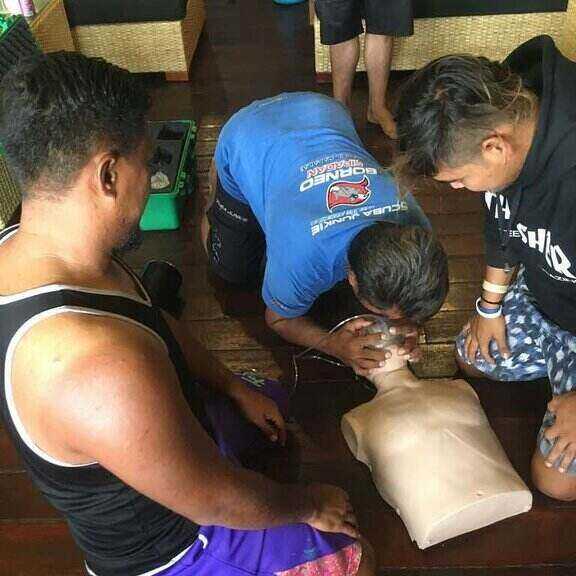
The Rescue Diver course is the final scuba course you must take before embarking on your journey to become an underwater guide. Your Rescue Diver knowledge and skills will serve as the foundation for your PADI Divemaster training. So, if you want to take the next step and make diving a career, this will be the next path in your journey!
While much of the course is serious and demanding, it is also a lot of fun! Throughout the course, your instructor will keep you on your toes by surprising you with different rescue scenarios; you may even be required to leap into the water for a rescue scenario while trying to enjoy a relaxing snack break. There will be plenty of laughter and fun in between the focused learning, as well as some diving along the way – which is always enjoyable!
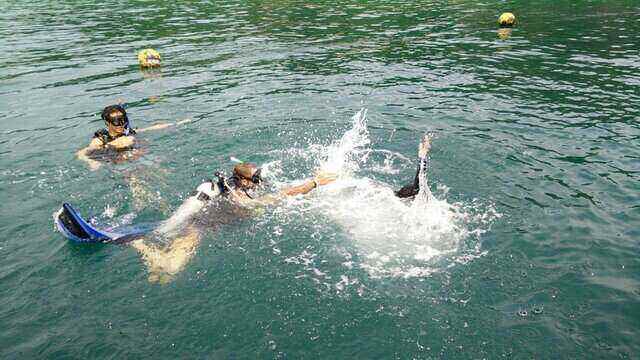
Despite all of the benefits listed above, the most important benefit of enrolling in a Rescue Diver course is having the skills and being prepared to carry out the proper procedure to save a life if the moment arises.
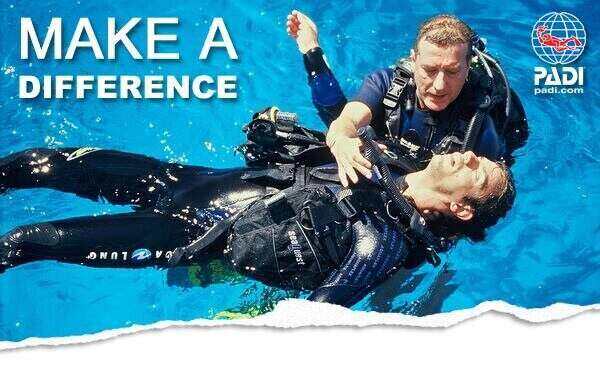
Do you think you have what it takes to be a rescue diver? If you are interested in continuing your dive education, give us a message!
Diving generally requires a number of skills and rules that must be followed in order for an individual to have a safe and enjoyable dive. However, due to the business of daily life, diving vacations and local trips are frequently postponed. When months or years pass between dives, it is time to think about taking a diving refresher course, check out some reasons below to think about why you should do a refresher.
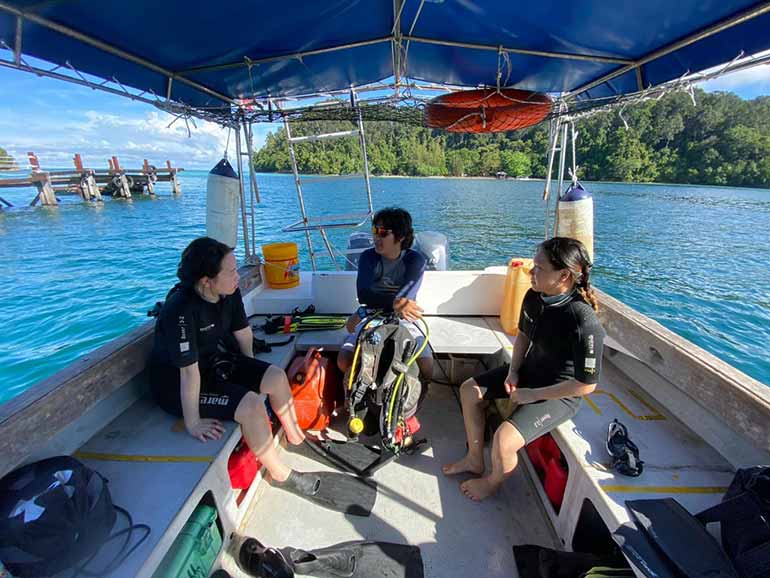
At Scuba Junkie, we usually will ask a guest to sign up for a refresher if they have not been diving in more than 6 months. However this might change depending on the level & number of dives that they have. For example, a new diver who hasn’t been diving at all for at least 6 months is recommended to take the refresher course where as a very experienced diver with over 100 dives might not need to. A responsible diver should be able to determine if they need a refresher course before going diving.
Being an inactive diver for an extended period of time will likely cause you to forget some diving knowledge. The skills & important tips that you once learned may fade away throughout the time if you haven’t been able to dive. This is why a refresher is important because it helps to review all the knowledge that you may have forgotten. Skills that will be taught in a refresher course include: mask clearing, regulator recovery, buoyancy control, buddy check etc. Scuba Junkie conducts our refresher course directly in the ocean. But don’t worry as we only do it at a shallow area where it is shallow enough for you to stand up if needed.
One of the most common problems that people who haven’t dived in a long time face is forgetting how to put their gear together. Diving gear is the most significant aspect of a diver’s underwater support system, thus it’s crucial to set it up properly before entering the water. The instructor will demonstrate how to properly assemble your gear and remind you of the pre-dive safety checks during the refresher session. They will also inform you of the usual blunders to avoid.

Some divers may develop a few bad diving habits after years of inactivity. They might well forget about proper dive procedures, putting their dive buddy or dive group in danger while diving. A refresher will assist in fine-tuning any potential issues. During the refresher, the instructor will be able to identify and correct any bad diving habits you have. Being a competent diver will make the dive safer and more enjoyable for everyone involved.
As we all know, the world is changing all the time, and the diving world is no exception. An Open Water course from ten years ago may look very different from one we have today. If you haven’t dived in a long time, you may have missed out on the most recent diving technology. The dive computers and cameras are the best examples of this.
If it’s been a while between your dives, take a refresher with Scuba Junkie Kota Kinabalu with one of our professional and experienced staff, its more than just skills, in the long run it will help you build confidence in yourself and fellow divers, making the experience unforgettable!
Whether you’ve done 10 dives or 1,000, the pre dive buddy safety check should be part of your routine. It ensures that everyone’s equipment is properly set up and operational, and it also helps you both become acquainted with each other’s gear.
It’s no secret that acronyms are a great way to remember things when you’re learning something new. But it’s been a while since your PADI Open Water Diver course, and you can’t remember what ‘BWRAF’ stands for or why you scribbled these 5 letters in your logbook?
The most commonly used acronym for remembering all steps of these so-called buddy checks is BWRAF, Begin With Review And Friend.
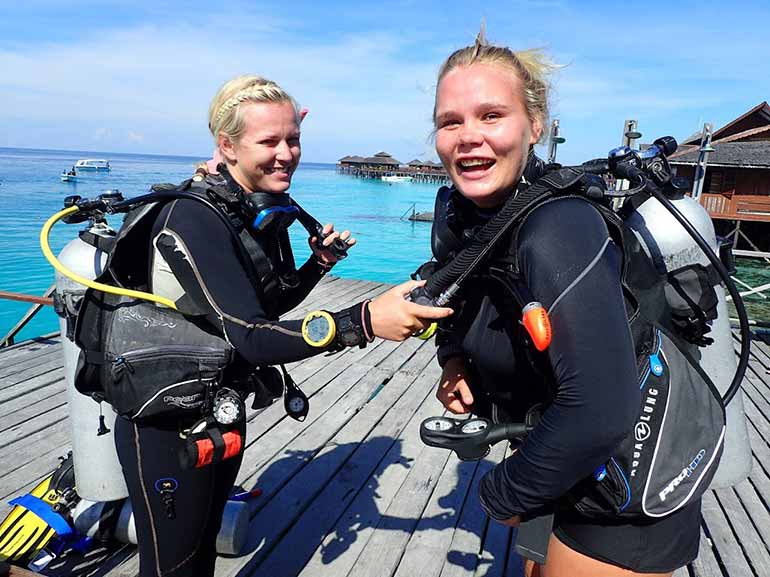
Here is a quick reminder on the meaning of BWRAF…
Check to ensure that everything is connected and functioning properly. Check that the low-pressure inflator hose is properly connected and that the buckles are securely fastened. Test the inflator button, as well as all of the deflate valves and releases, and make sure you can inflate the BCD orally (in case there are any issues with the power inflator underwater). Confirm that the tank is securely strapped in. Verify that all signaling devices are working and easily accessible.
Is your buddy wearing a weight belt or an integrated weight system? Check that the weight is correct and evenly distributed. Ensure that the weight pockets or belt are securely fastened and that either option allows for a quick release
The clips, straps, and buckles on your buddy’s BCD are also referred to as “releases.” Check ALL releases to ensure they are secure and properly adjusted, and instruct your buddy on how to open the release in an emergency. Don’t forget to double-check the tank strap and weight belt, in addition to the other releases. Check to see if there are any hoses or other items that could prevent a diver from exiting their equipment in an emergency.
Taking a quick breath or two off the regulator isn’t enough. You want to make sure that your buddy’s tank is fully opened and take multiple breaths while looking at an SPG. This allows you to ensure the tank valve is open, see how much air is available for the dive, verify the air monitoring device is functioning, and that the air tastes okay. Check you can breathe through the alternate air source and make sure it is correctly clipped off and visible so your buddy knows where to locate it in an emergency.
*We will need to adapt this during covid times.
Make a head to toe check to see if your buddy has everything they need (mask,snorkel,fins,computer, signal device and any specialized equipment which is needed for that dive). Secure loose hoses and other objects that may dangle and damage the reef. Check with your buddy if they are all right and ready to go!
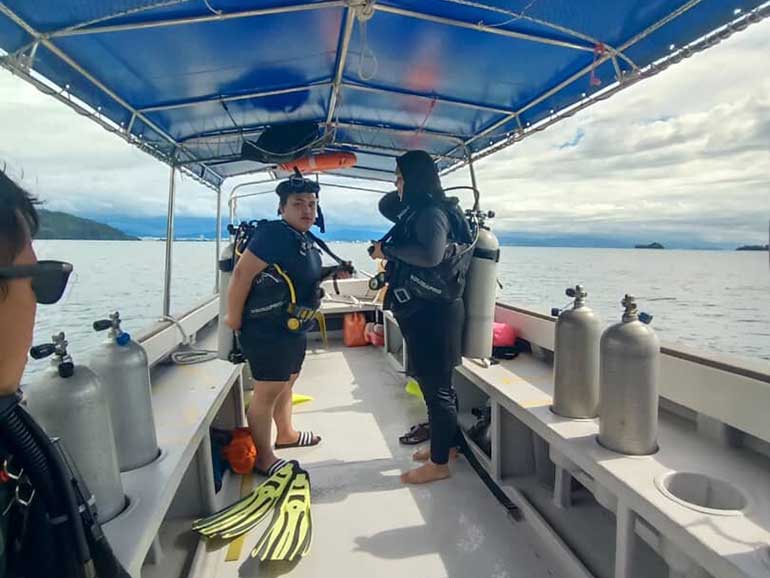
Mnemonics for BWRAF can be one of the more fun diving activities you can do above water! Your dive instructor would have probably given you a funny sentence to remember this (and some are definitely too rude to be shared online) Have a giggle exchanging all the ways to remember BWRAF!
Here are some of our favourites we have heard:
Do you have any other mnemonics to add to our collection? Let us know in the comment section!
Want to experience diving in different areas of Sabah? But not sure how to organise it or if you even have enough time? Don’t worry, we have you covered with our Sipadan – Kota Kinabalu Dive combo!
If you love the idea of extending city day trips diving with a resort stay, we have a fabulous new option for this now available in Sabah. We’ve teamed up with our Mabul Beach Resort to offer a full package with combined resort & day trips from the city, so you can get the most out of your diving adventure in this phenomenal destination.
You can choose from a number of combo packages or we can tailor one to your specific requirements.
A majority of visitors travel to KK to dive the renowned KK Marine Park (Tunku Abdul Rahman Marine Park), which includes the five incredible islands of Gaya, Sapi, Mamutik, Manukan, and Sulug. This well-known marine park has been around for almost 40 years, and Sabah Parks actively monitors and protects its marine biodiversity. As a result, this area is home to thousands of schooling fish, pristine coral reefs, unusual critters like sea horses, frogfish, and octopus, as well as Turtles, Black Tip Reef Sharks, Rays, and even Whale Sharks during the season. It is ideal for all levels of divers!
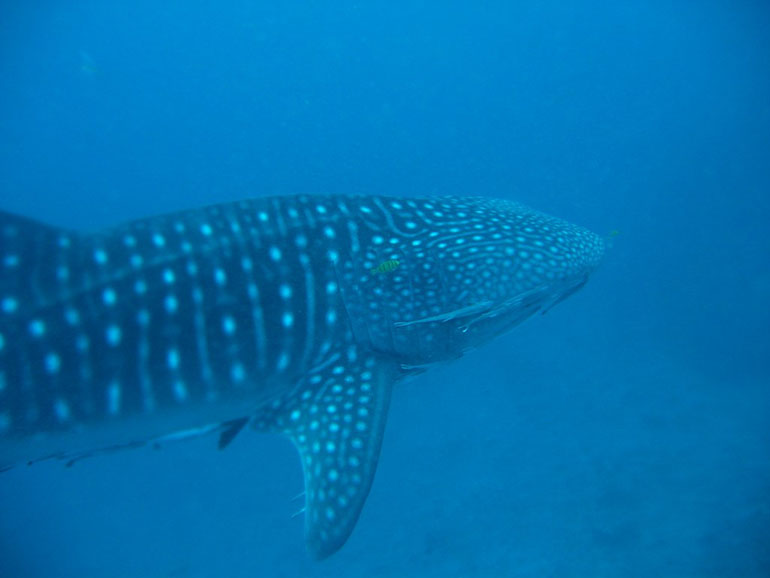
When passionate divers are asked to name their top dive destinations, Sipadan is typically at the top of the list. Sipadan is unquestionably one of the best dive destinations in the world, having been popularized by legendary sea explorer Jacques Cousteau. Today, the island drops over 2,000 meters to the seabed. Sipadan is located in the heart of the Indo-Pacific basin, which is home to some of the world’s most diverse marine ecosystems. The island is surrounded by strong currents, making it a meeting area for the entire marine food chain. This ecosystem is home to over 3,000 different fish species and hundreds of different coral species.
When you take a backward roll into the ocean, you’ll be amazed by the large number of green and hawksbill turtles. Sharks are also a virtual certainty, including whitetip reef sharks, grey reef sharks, and even hammerhead sharks if you’re lucky!
Schooling barracuda and big eye trevally often congregate in large numbers, creating a large tornado-like formation that is a once-in-a-lifetime experience, along with herds of bumphead parrot fish in the shallows. Let’s not forget about the macro-life; after spending some time looking at the wall, you’ll see nudibranchs, lobsters, octopus, and other interesting little creatures; there’s just so much to explore!
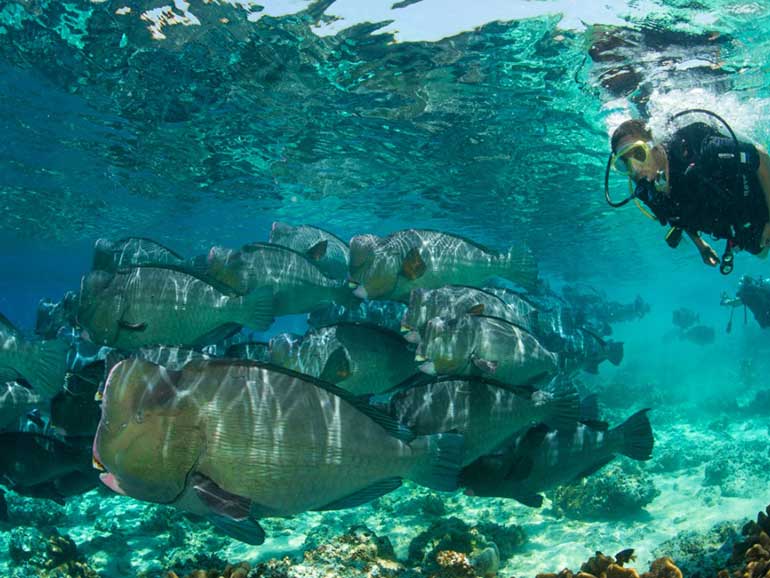
Scuba Junkie Mabul Beach Resort is an eco-friendly resort and strategically located on the beautiful Mabul island just a few steps away from some amazing shore dives on Mabul and a stone’s throw away from the incredible Sipadan island. With 30 en suite rooms situated on the beachfront, treat yourself to a little luxury at incredible rates. Our beautiful Mabul Beach Resort is the perfect base to explore Sipadan, Mabul and Kapalai.
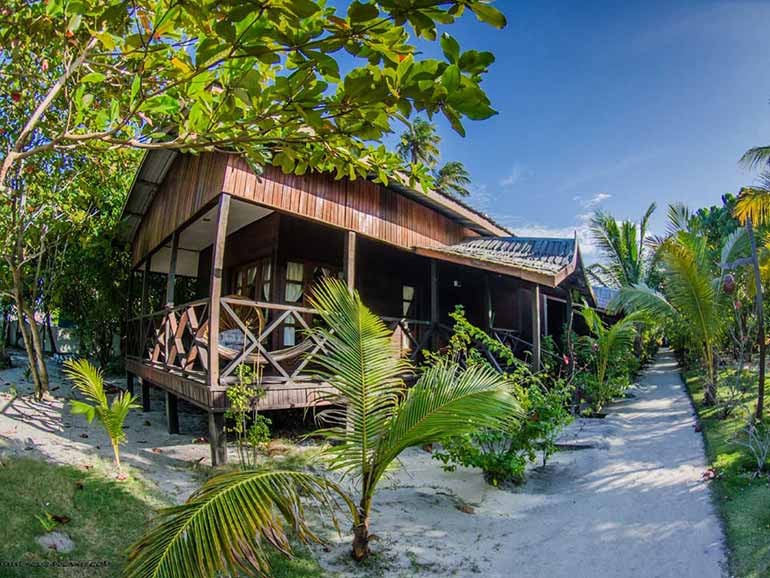
The best route to get from Kota Kinabalu to Mabul for your combo is to take a domestic flight with Air Asia or Malaysian Airlines from Kota Kinabalu to Tawau; there are a few options throughout the day, but you must arrive before 12pm to catch the 14:30 boat to Mabul. Alternatively you can do it the other way round, in this case you can catch the 10:30am boat back from Mabul and choose a flight anytime from 3pm onwards to Kota Kinabalu.
The package options are flexible, but to get the most out of your visit you can check out our examples that work best with transferring between both locations quickly and efficiently so you don’t waste extra time travelling, when you could be diving. We can’t wait to welcome you at both locations!